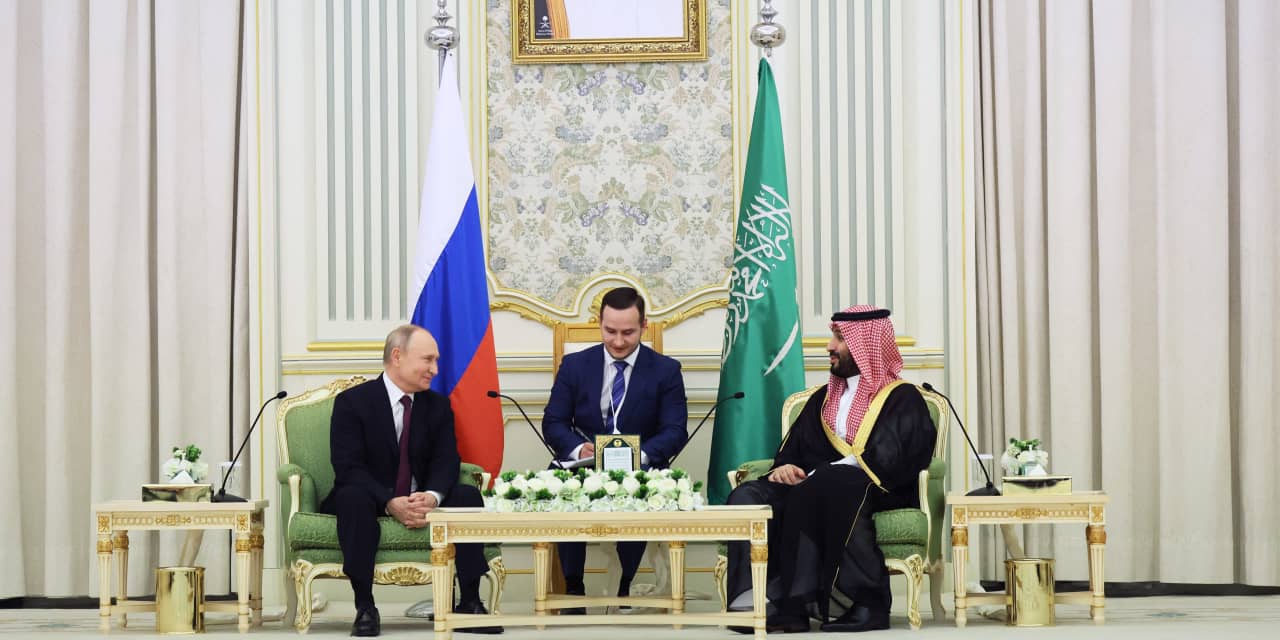Oil futures finished higher on Friday, but still posted a seventh-straight weekly loss — the longest streak of weekly declines since 2018.
Some analysts attributed Friday’s gain to supportive comments from Russia and Saudi Arabia, but prices still fell for the week as traders remain unimpressed by output cuts my major oil producers.
Price action
-
West Texas Intermediate crude for January delivery
CL00,
+0.04%
CL.1,
+0.04%
CLF24,
+0.04%
rose $1.89, or 2.7%, to settle at $71.23 a barrel after closing on the New York Mercantile Exchange. Based on the front-month contract, prices ended 3.8% lower for the week. Prices were down a seventh consecutive week, the longest streak of weekly losses since 2018, according to Dow Jones Market Data. -
February Brent crude
BRN00,
-0.25% BRNG24,
-0.25% ,
the global benchmark, rose $1.42, or 1.9%, to $75.47 a barrel on ICE Futures Europe, losing nearly 3.9% for the week. Both Brent and WTI posted losses in each of the past six sessions. -
January gasoline
RBF24,
+0.45%
rose 2.4% to $2.0498 a gallon, ending 3.4% lower for the week, while January heating oil
HOF24,
+0.15%
gained nearly 1.3% to $2.581 a gallon, for a weekly loss of 3%. -
Natural gas for January delivery
NGF24,
-1.16%
fell almost 0.2% to $2.581 per million British thermal units, ending 8.3% lower for the week.
Market drivers
Oil prices have been under additional pressure since an underwhelming Nov. 30 OPEC+ meeting that offered more voluntary cuts for the first quarter of 2024, but left traders questioning whether all countries would adhere to those.
At the meeting, OPEC+ producers agreed to voluntarily cut around 2.2 million barrels a day (mbd) of crude from the market in the first quarter of next year. That pledge included a widely expected extension of Saudi Arabia’s 1 mbd voluntary output cut and Russia’s 300,000 barrel-a-day cut to crude exports.
Some credit the rise in prices on Friday to verbal support from Russia and Saudi Arabia.
“This bounce came after a meeting between Russian leader Vladimir Putin and Saudi Crown Prince Mohammed bin Salman, emphasizing the ongoing efforts to stabilize global oil markets and manage production levels,” Stephen Innes, managing partner at SPI Asset Management, said in a note to clients.
A joint statement was released on Thursday following Putin’s visit to Riyadh with the Saudi Crown Prince. “In the field of energy, the two sides commended the close cooperation between them and the successful efforts of the OPEC+ countries in enhancing the stability of global oil markets,” said the statement released by the Kremlin.
“They stressed the importance of continuing this cooperation, and the need for all participating countries to adhere to the OPEC+ agreement, in a way that serves the interests of producers and consumers and supports the growth of the global economy,” the statement added.
Weekly losses
WTI and Brent crude settled nearly 4% lower for the week, logging their seventh straight week of losses, the longest streak of consecutive weekly declines for both since 2018, based on the front-month contracts.
WTI crude oil has lost more than 20% since its September high, as the market is “concerned with future global demand amid record output from the U.S.,” said Violeta Todorova, senior research analyst at Leverage Shares. “Concerns about slowing global growth and China’s economic health are mounting after rating agency Moody’s lowered the country’s rating to negative from stable.”
In the U.S., economic data released Friday were upbeat, however, with new jobs created in November showing a gain of 199,000, compared with a 190,000 gain forecast by economists polled by The Wall Street Journal.
Despite OPEC+ announcing voluntary output cuts of 2.2 million bpd for the first quarter of 2024, “traders are concerned that the cuts are voluntary and not mandatory, which raises the question of whether the cartel can really follow through,” Todorova said.
Record U.S. oil production and exports nearing 6 million barrels per day have also been “negating” OPEC+’s ability to influence crude prices, said Todorova.
S&P Global Commodity Insights on Friday reported that OPEC+ crude production fell by 110,000 bpd in November to 42.6 million bpd. OPEC’s largest producers, Saudi Arabia kept November output float on the month at 9 million bpd, in line with its pledge to voluntarily cut 1 million bpd from June levels.
On Friday, the U.S. Energy Department announced a solicitation for up to 3 million barrels of oil for delivery to the Strategic Petroleum Reserve in March, as part of its ongoing efforts to refill the emergency oil reserve following a historic drawdown in the SPR last year. It said it has already purchased nearly 9 million barrels for the SPR for an average of about $75 a barrel.
Meanwhile, oil traders kept watch on any market developments tied to the approval of a referendum in Venezuela last weekend to claim sovereignty over an oil-rich piece of land from Guyana.
Read: What the Venezuela-Guyana border dispute means for oil prices
Read the full article here




